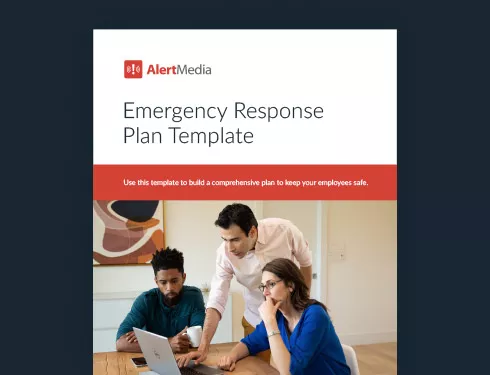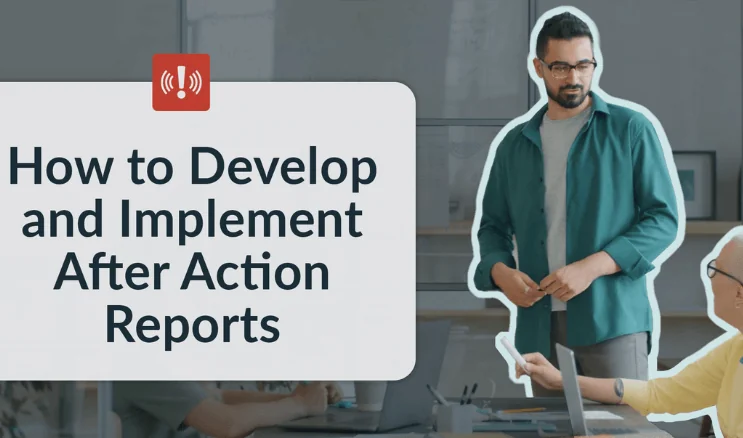![Four Phases of Emergency Management & How to Develop a Comprehensive Plan [+ Template]](https://www.alertmedia.com/wp-content/uploads/2021/12/Blog-2022-EmergencyMgmt-Plan-1024x536.jpg)
Four Phases of Emergency Management & How to Develop a Comprehensive Plan [+ Template]
Emergency management is crucial, expected, and incredibly difficult. Learn how to meet your emergency management duties in four phases.

When the world is increasingly chaotic and prone to disruption, how can an organization keep its people safe and its operations under control? The National Oceanic and Atmospheric Administration (NOAA) reported that large-scale weather disasters have been particularly frequent in the past few years compared to previous decades. The number of mass shootings is also trending upward—a 61% increase from 2019 to 2022.
Faced with more major disasters—both natural hazards and manmade threats—proactive emergency management planning is essential to ensuring employee safety and organizational resilience. And yet, FEMA reported that only 44% of adults felt prepared for a disaster in 2021—down from 59% just two years prior.
To guide your organization’s disaster preparedness efforts in 2023, it helps to approach emergency management in four phases. In this article, we’ll cover the ins and outs of each phase—whether you’re starting from scratch or improving the basic plan you already have.
Download Our Emergency Response Plan Template
The Four Phases of Emergency Management
Emergency management has four main phases: mitigation, preparedness, response, and recovery. These phases represent critical actions to minimize the impact of emergencies on your employees and operations. Each phase serves a slightly different purpose and should be used in different stages of a crisis.
1. Mitigation
Mitigation is taking action to reduce the severity of a crisis. For example, wearing a seatbelt mitigates the risk of injury in a car accident. For your business, strong passwords mitigate the risk of cybersecurity attacks, emergency evacuation plans mitigate the loss of life during a fire, and preparing your facilities for winter mitigates the impact of severe weather.
Performing a risk assessment will help your business identify what threats may require mitigation efforts. With common hazards identified, your business can develop a plan to avoid those risks altogether or reduce the harm done if a crisis is unavoidable. Those plans will include specific actions for employees to take during an emergency, a strategy for communication, and pathways toward recovery.
To help you determine what internal hazards your workplace may need to mitigate, the Occupational Safety and Health Administration (OSHA) has a list of top workplace safety violations. From preventing slips, trips, and falls to monitoring hazardous materials to handling heavy equipment properly, there are a number of safety-promoting actions that can help reduce the impact of common workplace hazards.
Of course, not all threats stem from internal workplace hazards. Severe weather, like winter storms and tornadoes, are out of your control—as are threats to public safety like disease outbreaks or acts of violence. Being able to monitor external threats with threat intelligence software and alert employees quickly will help prevent and reduce the negative impact of any disaster.
2. Preparedness
While mitigation may significantly reduce the impact of an emergency, not all crises and impacts are avoidable. With that in mind, being prepared for the worst with a strong emergency management plan will help your business respond effectively. Your organization’s plan should outline ways to address all of the potential threats to employee safety and business operations.
The preparedness phase ensures that your organization is ahead of an emergency and is equipped to handle it effectively. First, identify potential threats, and then define ideal responses to those threats. For instance, businesses in wildfire-prone areas should create defensible space around their facilities and have wildfire evacuation routes in place. Businesses in high-risk industries like construction and manufacturing should be prepared for workplace injuries, having easy access to first aid kits and first responder numbers.
“Disaster recovery/business continuity is a program, not a project.”
—Peter Steinfeld, Senior Vice President of Safety Solutions at AlertMedia
Flexibility and adaptability are essential, especially when you consider that workplace emergencies can span from power outages to bomb threats. Some disasters, like hurricanes or flash floods, might require more than one emergency plan—personnel might have to respond simultaneously to power outages, IT complications, and travel disruptions. The more elements of an emergency management program your business plan can address, the better.
Clear, consistent, and timely communication is also foundational to any effective emergency management plan. It ensures employees know what to do in the event of an emergency and they always have a lifeline to support. A robust emergency communication strategy will make sure everyone is on the same page and understands what is going on, whether they should be actively responding to the emergency or just keeping themselves safe.

3. Response
When an emergency does hit your business, you don’t want to just react; you want to respond. Where reactions are often chaotic or unpredictable, an effective response is intentional, well-planned, and action-oriented. They are tailor-made to types of hazards but still flexible enough to adjust in the face of unforeseen changes. Taking advantage of your prepared emergency plans in the face of a crisis will minimize the impact on the well-being of both employees and business operations.
The response phase is critical in an emergency, so being able to communicate with employees quickly is invaluable. A quality emergency communication solution will ensure that your messages reach the right people quickly, no matter where they are. Without communication, there is no way for key personnel to execute their designated emergency duties. There is no way to provide real-time emergency alerts and up-to-date information. There is no way to answer any employee questions that may arise.
With the right plan in place and a reliable communication system, you are set up to respond to the incident. Activate your emergency operations plan to maintain essential services and contact emergency services/law enforcement or your emergency management agency if necessary. While response activities take place over the short-term, they will see your business through the worst of the crisis and to the next phase of disaster management: recovery.
4. Recovery
Management of an emergency often continues long after the initial threat has passed. This is the recovery phase—where you address the impact of the disaster and mitigate further risk. Be prepared to take corrective actions to recover both the business and your employees.
Establishing a recovery plan during the preparation phase of emergency management will help guide the process. For instance, recovering from an information technology (IT) crisis might include restoring data and performing careful system updates. In the case of a public health crisis like the coronavirus pandemic, workplace recovery might include developing a COVID-19 vaccination policy or helping employees adjust to remote work.
Write an after-action report (AAR) and summarize your organization’s response to emergencies or drills. Additionally, documenting your recovery activities will help identify opportunities for improvement for future disasters and enable you to communicate event details with employees and other stakeholders effectively.
Learn a step-by-step framework for developing an after action report to ensure your organization is prepared for any emergency scenario.
What Is a Comprehensive Emergency Management Plan?
A comprehensive emergency management plan (CEMP) outlines an all-hazards approach that accounts for any plausible threat to your business. It outlines steps to take during critical events in order to optimize safety and minimize harm. While emergencies often occur when we least expect them, emergency preparedness can prevent emergencies from becoming catastrophes.
Comprehensive emergency management plans are broad, detailed plans that provide a framework with which any problem can be solved. This approach differs from an emergency response plan, which exists to mitigate the impact of one specific emergency on your business.
In the workplace, the emergency management planning process begins with a threat assessment to analyze the likelihood and severity of potential threats that could impact the business, from severe weather to acts of violence. Next, a plan of action is established and practiced. Disaster response roles are assigned, essential supplies are collected, and plans for post-disaster recovery are put into place.
“The best time to prepare for a disaster is in a classroom, not when a disaster occurs.”
—Larry Robert, Business Continuity/Disaster Recovery Manager, Federal Reserve Bank of Boston
Maintaining a proactive, rather than reactive, response to emergencies ensures that employees stay as safe as possible. A strong plan also helps maintain the continuity of operations during any unpredictable situation.
Why Build an Emergency Management Plan?
At their core, CEMPs exist to protect people. All employers have a duty of care to their employees—in other words, businesses are obligated to keep people safe while at work.
In addition to providing a safe work environment, there are other benefits to establishing a preparedness plan. Effective preparedness activities reduce loss of life and property damage, speed up recovery, and minimize the overall cost of disaster recovery. One study even found that every $1 invested in disaster preparedness can save up to $11 in total cost.
The Federal Emergency Management Agency (FEMA) estimates that about 25% of businesses won’t reopen after facing a disaster. Effective preparation will help reduce the negative impact an emergency has on business operations and promote a return to normal operations and success. Though it might seem like more work on the front end, committing to a comprehensive emergency management plan is both a wise business decision and invaluable when it comes to protecting your people.
“The number one goal is to always take care of the health and safety of our [employees].”
—Justen Noakes, Director of Emergency Preparedness, HEB
How to Build a Comprehensive Emergency Management Plan
Now that you have the basics of emergency management, it’s time to build a plan that works for your business. Here are five practical steps to guide you:
1. Determine your emergency risks
First, sit down with your organization’s key stakeholders and run a risk assessment to determine the threats that are relevant to your business and its employees. Remember to take seasonal and regional factors into account—like preparing for hurricane season or severe winter weather. Other hazards might pose a threat year-round, like cybersecurity issues or workplace violence.
2. Account for your whole team
When building your CEMP for the year ahead, consider all members of your business team. For instance, how can you maintain accessible evacuation routes for personnel with disabilities? Consider vendors who might be onsite in the event of an emergency and how you can effectively care for and communicate with them too. Identify the key stakeholders responsible for these actions, and build contact lists for different groups based on location or potential for impact.
3. Find your technology solutions
There are many software solutions that can make building and executing your CEMP much easier, and you want to have them implemented before a crisis hits.
Threat intelligence solutions can help you identify and assess emerging threats that could impact your business. Emergency communication software allows for rapid, multichannel notifications and up-to-date information in the case of a crisis. Using two-way emergency communication software also allows employees to ask questions and gather the information they need to remain safe and maintain essential operations.
Since technology should make things easier, not harder, finding all-in-one platforms for emergency communications is always better than patching together various disconnected systems. Emergency communication solutions with integrated threat intelligence and employee safety monitoring, like AlertMedia, make staying connected easier on you and your employees.
4. Run drills
A plan is only that unless you ensure everyone knows how to use it. True preparedness requires practice. Running evacuation drills, such as natural disaster or fire drills, will show everyone what they should do and where they should go in an emergency situation. Running an active shooter drill will help employees respond appropriately in a potentially paralyzing situation.
Disaster recovery tabletop exercises are also a great way to prepare for when disaster strikes in the workplace. They are low-stakes, simulated scenarios where employees can put their strategic plans into practice. A tabletop exercise creates a safe learning environment and is also a good way to identify potential opportunities for improvement.
5. Plan for communication
Having a communication system in place is invaluable in a variety of situations—from winter weather to political demonstrations to the global pandemic. The ability to disseminate vital information and stay in touch with employees is absolutely essential in the event of an emergency.
Mass notification solutions allow you to keep everyone informed. You can ensure employees have accurate, rapid, and regular updates by using a two-way, multichannel alert notification system that will help minimize chaos and maximize employee safety.
Event page functionality can further ensure employees receive consistent and accurate information during a crisis. With a centralized hub to act as an incident command system and provide ongoing updates and streamline access to critical resources for any incident, employees are always on the same page. Disseminating information in this way prevents misinformation and reduces confusion during critical events.
Planning for Your Safest Year Yet
There’s no better time than now to look over your current emergency management plan and make improvements for the year ahead. Don’t wait until you’re mid-crisis to start getting organized—get prepared now. Need to do more research? Subscribe to The Employee Safety Podcast. And our newsletter, The Signal, is packed with safety insights and action-item alerts.
Wherever you are on the journey toward building a stronger emergency preparedness plan, AlertMedia has the resources your business needs to find success. With a comprehensive emergency management plan—supported by robust emergency communication software—you can be confident that you will have your safest year yet.


![6 Steps to Creating an Effective Emergency Response Plan [+ Template]](https://www.alertmedia.com/wp-content/uploads/2023/10/Blog-Emergency-Response-Plan.webp)


